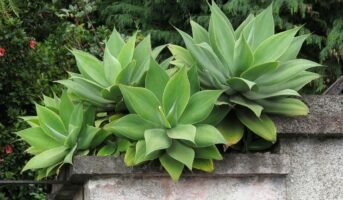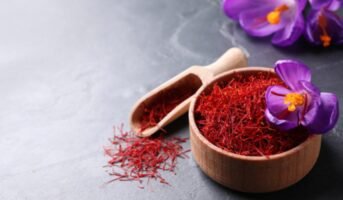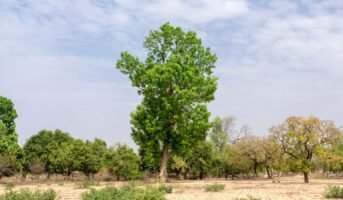What is Pepper Plant?
A flower stalk in the Piperaceae family called Black Pepper (Piper nigrum) is grown for its peppercorn-shaped fruit, which is often dried and used as a spice and condiment. The fruit is a drupe (stone fruit), and it is dark red, about 5 mm (0.20 in) in diameter (fresh and thoroughly developed), and it has a solitary pepper seed inside of a stone.
Merely called pepper, black pepper, green pepper, or white pepper, peppercorns and powdered pepper made from them are unripe fruits cooked and dried (ripe fruit seeds).

Source: Pinterest
The woody climber black pepper plant may use its aerial roots to grow as high as 10 metres (33 ft). It has large, lustrous green leaves that are placed alternately. The tiny blooms are arranged in thick, thin spikes with around 50 flowers per spike.
The fruits, sometimes known as peppercorns, are drupes with a diameter of 5 mm (0.2 inches). At maturity, they become reddish-red and produce a solitary seed. Their flavour is spicy, biting, and extremely strong; their scent is piercing and fragrant. Up to 3% of essential oil found in ground black pepper possesses the aromatic flavour of capsicum peppers but none of the pungency.
See also: Tips to grow and take care of anthurium
Pepper plant: Key facts
| Botanical name | Piper nigrum |
| Common name | Pepper |
| Type | Perennial herb |
| Leaf type | Oblong to egg- or lance-shaped |
| Flower | Most pepper plants have white blossoms, but some pepper varieties have purple flowers. Most purple-flowered pepper plants will also produce purple (unripe) peppers. |
| Varieties available | 600 |
| Height | 7 feet |
| Season | Spring |
| Sun exposure | 6-12 hours of direct sunlight daily |
| Ideal temperature | The ideal temperature is 23 -32°C with an average of 28°C. |
| Soil type | Peppers prefer rich soil that’s more sandy or loamy. |
| Ideal location for placement | A sunny, well-drained spot where peppers haven’t grown recently. |
| Ideal season to grow | Spring |
| Maintenance | Low |
know about: aphids bugs
Pepper plant: Types
Black pepper
Due to its antioxidant, anti-microbial, and gastro-protective components, black pepper (Piper nigrum L.) is a significant healthy food. Piperine, the active component in black pepper, is part of a complex phytochemistry containing essential oil, oleoresins, and alkaloids.
Recent research on cell culture and animal models anticipated black pepper’s effectiveness against various diseases. Black pepper and its bioactive constituents may aid chemoprevention and tumour development management.
Additionally, piperine, one of Piper nigrum’s main alkaloid components, helps with gastrointestinal function, food intake, and intellectual brain function.
This extensive essay has attempted to clarify the antioxidant, antibacterial, anti-inflammatory, gastro-protective, and depressive properties of black pepper.
The highlight of the text is the combinatorial interaction of black pepper with various medications and minerals. However, animal studies have demonstrated the health advantages of black pepper.
White pepper
In foods that need a peppery taste but don’t want any black flecks, like white sauces and potato dishes, white pepper is frequently used. Ground white pepper is used in Chinese cooking to flavour soups, marinades for meats and poultry, and hotter stir-fries.
Compared to Sichuan peppercorns or black pepper, it is distinct. Similar to black pepper, white pepper is a spice made from the dried fruit of the Piper nigrum pepper plant. It often has a milder flavour than black pepper and a simpler taste. There are whole and ground white pepper options.
Green pepper
A green pepper, also known as bell pepper, is a fruit with a slight sweetness and is used in many regional cuisines. The green pepper has little to no heat, unlike its hot siblings. Thus, individuals who don’t like spicy meals can safely consume them. Green peppers taste great in several dishes, but choosing them carefully is essential to get the finest flavour.
Given that it might be challenging to determine whether the green peppers you can get are ripe, they need clarification on produce. Red, yellow, and orange peppers become green before they mature.
The green peppers you get at the grocery store are frequently immature yellow or red peppers, which are significantly bitter and less pleasant. The option is further complicated by green peppers that maintain their green colour even after fully maturing.
Red peppercorns
Crimson peppercorns have been allowed to grow entirely and turn red. They are often picked, dried, and then turned into black peppercorns. The black skin may then be scraped off to get white peppercorns. They may thus be more elusive because black and white pepper is their primary usage.
They have a flavour comparable to black peppercorns, albeit brighter, fruitier, and not as intense. They make a terrific accent to salads, shellfish, dressings, butter-based sauces, and chicken meals since they are somewhat sweet and spicy.
Pink pepper
Pink pepper is a member of the Anacardiaceae family and is indigenous to Chile and Peru. It is not a new type of pepper; although its fruits are identical, they are completely different in texture and flavour.
Additionally, it is grown in Africa, various Mediterranean nations, and other regions of America. It is a little evergreen tree with fragrant foliage and pink fruit clusters. Due to its remarkable capacity for adaptation and propensity for invasiveness, its cultivation is restricted in several places (including Florida and Australia) to preserve the natural ecosystem and safeguard the local flora.

Source: Pinterest
known about: Capsicum Plant
Pepper plant: Growth and propagation
You can form peppercorn plant clones of the parent plant easily by burying part of a low-lying stem under the soil—a technique known as layering. In one growing season, the buried part of the stem will produce roots, and you can then sever this new plant from the parent plant.
In a more advanced technique called air-layering, usually reserved for woody stems, you can slice away the surface of the stem and pack it with moist sphagnum moss. Enclose the moss with plastic food wrap and secure the ends with electrical tape. Allow three months for sufficient roots to develop before removing this new plant from the parent.
Growing peppercorn plants from seed
It takes patience to grow peppercorn plants from seed, but this method is valuable if you want to start plants to sell or give to friends. Take a mature (red) peppercorn berry from your vine. Soak the berry overnight to hydrate it, and plant it just beneath the soil surface. Keep in a warm room between 75 and 85 degrees Fahrenheit; use a heated germination mat for best results. Germination will occur in about 30 days.
Potting/repotting peppercorn plants
Peppercorn vines are slow-growing perennial vines and seldom need repotting. When plants begin to show signs of being root bound, gently tease the root ball from the container and repot using a loamy-bagged potting mix. As a young plant, the peppercorn vine makes a handsome specimen for hanging baskets. You can usually maintain them for at least two seasons this way.
However, if you intend to cultivate fruit-producing plants, you must move the vines to a larger container in a greenhouse or conservatory environment. When you transition your plants to an upright growing position, you must provide a trellis for the vines to cling to. A healthy vine in a tropical greenhouse setting can grow 8 to 13 feet long.
Harvesting peppercorn
Spices like pepper are riding the wave of the healthy eating trend as scientists learn more about the disease-fighting properties of these tiny wonder plants. A recent study in”Critical Reviews in Food Science and Nutrition” explores the “antioxidant, antimicrobial, anti-inflammatory, gastro-protective, and antidepressant activities of black pepper.” You can use the fruits of the peppercorn in three ways as they progress through the ripening stages.
Take the earliest green fruits and pickle them, making them soft and not very spicy.
If you harvest the peppercorns when they begin to turn red, allow them to dry for a few days. The result is the common black peppercorn.
White pepper comes from the most mature stage of ripening fruits. When the berries are completely red, pick them and remove the outer red husk, leaving you with a white kernel, which you can grind like regular black peppercorns.
Pepper plant: How to take care of the plant?
Location
Always pick a spot to put pepper plants that receive enough bright, indirect sunshine and stay damp.
Use a shade cloth that filters at least 50% of the sunlight if you’re planting in a sunny place. Provide full sun if growing in a chilly environment.
Soil
The optimal soil for growing black pepper is rich, moderately clayey, and moisture-retentive. Proper drainage is always crucial when growing black pepper in a container or on the ground.
Plant harm can result from waterlogged soil. The pH of the soil can range from 5.5 to 7, and if it is excessively acidic or alkaline, lime or sulphur should be added.
Humidity
The more dampness, the better for the peppercorn plant. For this, often spritz the plant with water. Place the pots on a saucer with water if you’re growing them in pots; this will raise the humidity level.
Fertilisation
Apply 10 kg of well-rotted compost or manure annually to a mature plant while growing in the ground to keep the soil nutrient-rich. Apply compost as a side dressing to plants in containers. At the start of the growing season, fertilise it with balanced 10-10-10 or 20-20-20 slow-release fertiliser, as directed by the product’s label.
Ideal temperature
For such a plant to grow successfully, the temperature must be consistent at between 75 and 85 degrees Fahrenheit (24 and 30 degrees Celsius). The pepper plant, however, can withstand temperatures of 50 F to 104 F. (10-40 C).
Light requirements
Have been using a shading cloth that filters at least 50% of the sunlight if you’re growing in a sunny place. Provide full sun if growing in a chilly environment.
Mulching
Utilise organic mulching to stop evaporation and weed growth.
Diseases and pests
Root rot brought on by overwatering is the most prevalent illness that affects it. It may come under assault from pests, including aphids, snails, and scale insects. Also watch out for spider mites when growing inside.
What are the uses of Pepper plant?
- Black pepper’s constituents, particularly its main component piperine, may help with digestion difficulties, enhance nutritional absorption, and prevent cell damage.
- Numerous studies demonstrate that your body uses black pepper as an antioxidant.
- The function and absorption of several minerals and healthy substances can be improved by black pepper.
- Black pepper could encourage healthy digestion.
Pepper plant: Toxicity
Black pepper used in typical culinary doses and supplements containing up to 20 mg of piperine seems safe. It should be used cautiously while taking some medicines together since it may increase drug absorption.
FAQs
How long does it take for a pepper plant to grow fully?
Pepper plants take around 60 to 90 days to grow fully.
Do pepper plants like sun or shade?
Pepper plants enjoy full sunlight.
How do you take care of a pepper plant?
Peppers need continually wet soil, and plants grown in containers typically need watering more frequently than those planted in the ground. Consider regular watering, especially in the middle of the summer.
What is the best month to plant pepper?
To grow, peppers require warmth and sunlight. In most regions, seedlings must be started indoors or under cover since warmth is crucial for germination and afterwards to promote good development. Plant seeds no later than two months before the final date of your local frost in late winter or early spring.
Housing News Desk is the news desk of leading online real estate portal, Housing.com. Housing News Desk focuses on a variety of topics such as real estate laws, taxes, current news, property trends, home loans, rentals, décor, green homes, home improvement, etc. The main objective of the news desk, is to cover the real estate sector from the perspective of providing information that is useful to the end-user.
Facebook: https://www.facebook.com/housing.com/
Twitter: https://twitter.com/Housing
Email: [email protected]











